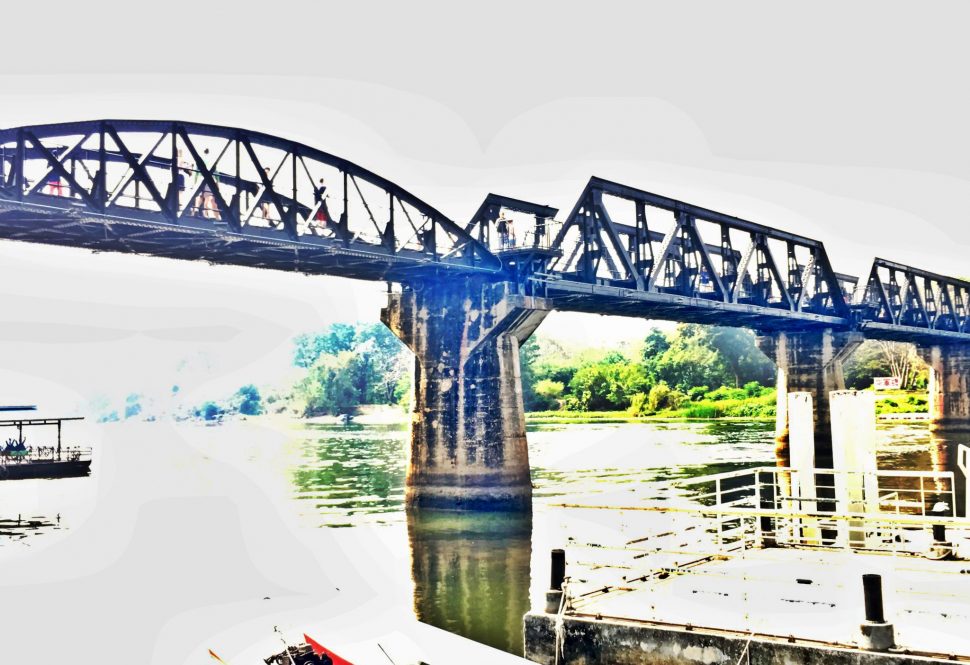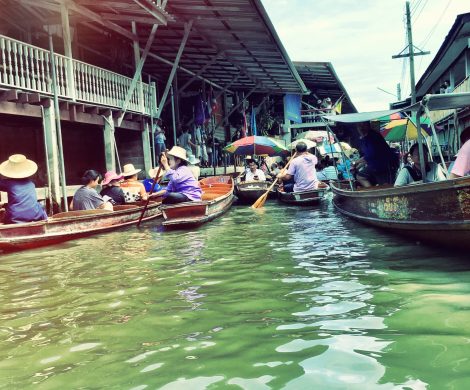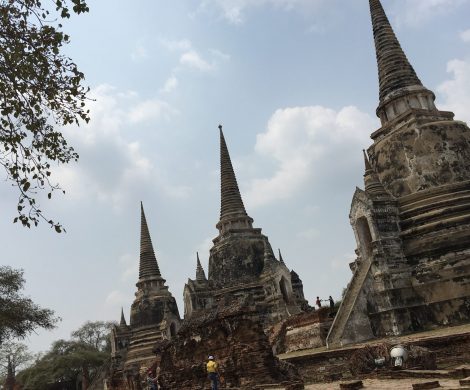
On a recent work visit to Bangkok (yeah, people actually do go there on business trips!), I found myself with a free day towards the end of my visit and I was determined not to waste it. Which is how I found myself bleary-eyed at 6 AM waiting for a van to pick me up for the two and a half hour drive to Kanchanaburi from Bangkok.
Kanchanaburi, the ‘City of Gold’ is about 120 Kms west of Bangkok on the border of Thailand and Myanmar. You may not have heard of Kanchanaburi, but it’s very likely you know of one of its main attractions – The Bridge over River Kwai.

Located at the confluence of the Kwhae Noi and Khwae Yai Rivers (more on this later in the post), which merge to form the Mae Klong River (also known as the Mekong) Kanchanaburi is just a bit bigger than a town, but one filled with such natural beauty, that my day trip barely scratched the surface. The landscape of Kanchanaburi is dotted with rivers, waterfalls, mountains, caves, and forests. Gone are the ubiquitous congested streets and skyscrapers of Bangkok. Instead, you’ll see lush green paddy fields, wide roads with the odd moped whizzing by and experience a much slower pace of life.
Visitors spend anything between 3-10 days taking in all that the place has to offer —kayaking, trekking, hiking, biking, rock climbing, elephants, tigers…the list is endless. If you can survive the heat, that is. I visited in the first week of March when the heat is almost at its worst (supposed to peak the thermostat in April). It was almost 40 deg C, the day I was visiting, and I was glad I decided to take the air-conditioned tour van instead of choosing the biking tour option, which I originally wanted. I don’t think I could have survived that ride.
In the late 19th century, Kanchanaburi was established by King Rama I as a defensive outpost against possible Burmese attacks, given its proximity to the border. Later in World War 2, the town played a very different role, memories of which haunt it till today.
Since I had only one day, I could only visit 4 of the city’s attractions on a guided tour I signed up for, from Bangkok. In hindsight, if I could, I would have picked a different itinerary. Nevertheless, what I did see piqued my curiosity enough that I want to return with my husband some day and spend a few days exploring Kanchanaburi.
Here’s what I got to see!
Memories of War
To understand and put the key attractions of Kanchanaburi in context, one needs to understand its role in World War 2. The Japanese Imperial army invaded Burma in 1942 and seized control of it from the British. To supply their forces in Burma, the Japanese depended upon the sea, bringing supplies and troops to Burma around the Malay peninsula and through the Strait of Malacca and the Andaman Sea. This route was vulnerable to attack by Allied submarines, especially after the Japanese defeat at the Battle of Midway in June 1942.
To avoid this hazardous route they decided to build a railway line between Ban Pong, Thailand to Thanbyuzayat, Burma. This was also meant to play a key role in their planned land invasion of India. And they had access to a significant free labour force. 330,000 people worked on the notorious Burma-Siam Railway line that included 250,000 Asian labourers and 61,000 Allied Prisoners of War (POWs). The living and working conditions on the Burma Railway were often described as “horrific”, with maltreatment, sickness, and starvation. About 90,000 of the labourers and approximately 16,000 Allied POWs from England, Australia, Holland and America died during the construction of what came to the known as the Death Railway. It is believed that one life was lost for each sleeper laid on the track.
The Bridge on the River Kwai, as immortalized in the Hollywood movie and the book it’s based on, is part of this railway line passing through Kanchanaburi. The bridge in the film looks nothing like the steel bridge at Kanchanaburi. (The movie itself was filmed in Srilanka). At that time the stretch of river that ‘The Bridge on the River Kwai’ spans was still called the Mae Klong. The bridge was 415 meters long and made of wood when it was completed and was originally about 100 meters downstream from where the current bridge stands. It was bombed and destroyed by the Allied Forces and rebuilt with iron. The present bridge was restored after the war, and only small parts remain in it from the original bridge.
After its release in 1957, the film was such an international success — it won seven Oscars — that tourists came flocking to Thailand searching for ‘The Bridge on the River Kwai’. So, in 1960 the town of Kanchanaburi changed the name of the Mae Klong river in the vicinity of the bridge to the Kwae Yai. So really, it is the Bridge on the River Mae Klong. And the bridge as depicted in the book and the movie doesn’t actually exist!
It’s a strange case of real life adjusting to align with celluloid!
War Cemetery
Our first stop in Kanchanaburi was the War Cemetery. Graves of 6,982 POWs, mostly Australian, British, and Dutch who died during the construction of the Death Railway are buried here.
I was quite surprised to see the beautifully tended lawns with rows upon rows of immaculately tended headstones. I don’t know what I was expecting, but it wasn’t this very peaceful and serene space that lends an air of perspective to the incredible violent loss of life this war project incurred.

JEATH Museum
From the war cemetery, we went to visit the JEATH War Museum. This is not to be confused with the Death Railway Museum adjacent to the war cemetery. For some reason, our tour did not include that one and we were taken to see the other war museum dedicated to the Death Railway about 10 mins away. JEATH is an acronym for the primary nationalities of those involved in the construction of the Burma-Siam Railway – Japan, England, Australia, Thailand, Holland.
The JEATH Museum is located on the grounds of a Buddhist temple. It was definitely one of the strangest museums I have ever been to. In fact, the word ‘museum’ doesn’t even seem applicable here. I think the idea was to recreate a model of the bamboo huts in which the POWs were housed during the construction of the railway. When our tour guide pointed to a dilapidated hut-like structure and told us that was the entrance to the museum, I honestly thought he was joking for a moment.
The ‘museum’ displays graphic imagery of the terrible conditions inflicted on POWs; the many young men that died and the many that survived to tell the story. Unfortunately, the exhibit was poorly put together, falling apart, rusting and covered with cobwebs. There is an overall feel of neglect and disrepair, which is quite sad if this was meant to be a form of respect for those fallen soldiers. Some of them were just in their early 20s….


I wandered around the temple grounds and saw monks milling about. Some were sitting in small groups in an open courtyard area, talking, eating, writing.
The JEATH Museum is on the banks of the Mae Klong river. From here, you can take a long-tail speedboat to the Bridge on the River Kwai. It’s a pleasant 20-minute boat ride and I enjoyed the cool river breeze and the spray of water as we cut through the river on an incredibly hot day.
The boatman helpfully pointed out that we were going to pass through three rivers – from Mae Klong river to Kwai Noi and finally to Kwai Yai where we would dock at the foot of the famous bridge. At some point, he pointed to a tributary and said we could take that to get to Myanmar in 2 days. We passed a number of beautiful wooden, traditional Thai style homes on the river. Old wooden houses with corrugated tin roofs line the Mae Klong canal.
About 15 minutes later, the bridge came into view.
Bridge on the River Kwai
As I stepped off the boat, my first impression of this notorious bridge was a mix of loud pop music, tacky stalls, over priced restaurants and a gazillion tourists milling about taking selfies on the bridge. I kept trying to see what was so special about the bridge. A bridge is a bridge, and this wasn’t a particularly photogenic one either. What caught my attention was a magnificent 55 ft statue of Kuan Yin, the Goddess of Mercy against the backdrop of the bridge, which is part of a Buddhist retreat nearby.
I took a walk on the bridge, something everyone does. No doubt, it’s a picturesque view, given the natural beauty of the town and the river flowing below. Three trains cross the bridge each day and slow down considerably allowing tourists to scamper to safety in little platforms provided on the bridge itself. Overall, it was an underwhelming experience for me. But then, that’s just me.


By now, it was nearly noon and the sun was blazing hot and our little tour group was parched. The guide told us we can get back into the safety of the air-conditioned van to get some refreshments and take a short nap since we were going to drive around 50 km to our lunch stop, next to the next major attraction of our trip – Wat Pha Luang Ta Bua Yanasampanno. Better known as the Tiger Temple.


















